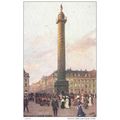St. Albans, Hertfordshire - multiview real photo 1962
- Condition : Used
- Dispatch : 2 Days
- Brand : None
- ID# : 128323559
- Quantity : 1 item
- Views : 306
- Location : United Kingdom

- Seller : justthebook (+1703)
- Barcode : None
- Start : Mon 19 May 2014 15:20:23 (EDT)
- Close : Run Until Sold
- Remain : Run Until Sold
Checks/Cheques
 for 1 item(s) edit
for 1 item(s) edit
Shipping Calculator
More Listings from This Seller view all
Seller's Description
- Postcard
- Picture / Image: St. Albans, Hertfordshire multiview: Ye Old Fighting Cocks / The Clock Tower / The Town Hall / French Row / The Monastic Gateway - real photo type
- Publisher: The St. Albans series Real Photograph
- Postally used: yes
- Stamp: 2&half d. red Wilding
- Postmark(s): St. Albans 21 Aug 1962 'World Health Organisation Fights Malaria' slogan postmark
- Sent to: Kilmien, by Dunoon, Argyll, Scotland
- Notes / condition:
Please ask if you need any other information and I will do the best I can to answer.
Image may be low res for illustrative purposes - if you need a higher definition image then please contact me and I may be able to send one.
------------------------------------------------
Postage & Packing:
UK (incl. IOM, CI & BFPO): 99p
Europe: £1.60
Rest of world (inc. USA etc): £2.75
No additional charges for more than one postcard. You can buy as many postcards from me as you like and you will just pay the fee above once. (If buying postcards with other things such as books, please contact or wait for invoice before paying).
Payment Methods:
UK - PayPal, Cheque (from UK bank) or postal order
Outside UK: PayPal ONLY (unless otherwise stated) please. NO non-UK currency checks or money orders (sorry).
NOTE: All postcards are sent in brand new stiffened envelopes which I have bought for the task. These are specially made to protect postcards and you may be able to re-use them. In addition there are other costs to sending so the above charge is not just for the stamp!
I will give a full refund if you are not fully satisfied with the postcard.
----------------------------------------------
Text from the free encyclopedia WIKIPEDIA may appear below to give a little background information (internal links may not work) :
*************
St Albans /snt '??lb?nz/ (Lat. Villa Sancti Albani or Villa Albani) is a city and unparished area in southern Hertfordshire, England, around 19 miles (31 km) north of central London. It forms the main urban area of the City and District of St Albans. It was the first major town on the old Roman road of Watling Street for travellers heading north and became the Roman city of Verulamium. It is a historic market town and is now a dormitory town within the London commuter belt.
The St Albans area has a long history of settlement. The Celtic Catuvellauni tribe had a settlement at Prae Hill a mile or so to the west. The Roman city of Verulamium, second-largest town in Roman Britain after Londinium, was built alongside this in the valley of the River Ver a little nearer to the present city centre.
After the Roman withdrawal, and prior to becoming known as St Albans, the town was called Verlamchester or Wæclingacaester by the Mercian Angles.
The mediaeval town grew up on the hill to the east of this around the Benedictine foundation of St Albans Abbey. This is the spot where tradition has it that St Alban, the first British Christian martyr, was beheaded some time before AD 324. It was at one time the principal abbey in England and the first draft of Magna Carta was drawn up there, reflecting its political importance. The Abbey Church, now St Albans Cathedral (formally the Cathedral & Abbey Church of St Alban but still known locally as The Abbey) became the parish church when it was bought by the local people in 1553, soon after the priory was dissolved in 1539. It was made a cathedral in 1877 when the City Charter was granted. There is evidence that the original site was somewhat higher up the hill than the present building and there had certainly been successive abbeys before the current building was started in 1077.
St Albans School, a public school which occupies a site to the west of the Abbey and which includes the 14th century Abbey Gateway, was founded in AD 948 and is the only school in the English-speaking world to have educated a Pope (Adrian IV). It numbered amongst its buildings until comparatively recently a converted former hat factory, a link with the city's industrial past. Nearby Luton was also a notable centre for the hat making industry.
The road between the Abbey and the school, running down to the River Ver and Verulamium Park (on part of the site of Roman Verulamium), is called Abbey Mill Lane. On this road are the palaces of the Bishops of St Albans and Hertford. The Fighting Cocks, one of the oldest public houses in England, is at the Verulamium Park end of this road. Also on the River Ver, at the St Michael's Village end of the park, is Kingsbury Watermill, which is now maintained as a museum with a waffle house attached.
Two battles of the Wars of the Roses took place in or near the town. The First Battle of St Albans was fought on 22 May 1455 within the town of St Albans itself, and the Second Battle of St Albans was fought on 17 February 1461, just to the north.[3]
The growth of St Albans was generally slow before the 20th century, reflecting its status as a rural market town, a Christian pilgrimage site, and the first coaching stop of the route to and from London - a fact which also accounts for its numerous inns, many dating from Tudor times. In the inter-war years it became a popular centre for the electronics industry. In the post-World War II years it was expanded significantly as part of the post-War redistribution of population out of Greater London that also saw the creation of new towns.
The city today shows evidence of building and excavation from all periods of its history and is a tourist destination. Notable buildings include the Abbey and the early 15th century Clock Tower (pictured). The clock tower is one of only two similar towers in England; it is also the site of an Eleanor cross, which was pulled down in 1703, it had suffered years of neglect, and had been struck and badly damaged by a carriage, it was replaced by the town pump. A fountain was erected in its place in 1874, now relocated to Victoria Place.
Running into St Albans from the south is Holywell Hill (generally pronounced ""holly-well hill""), its name taken from the story of St Alban. Legend has it that the Romans were looking for a traitor that had been injured and Alban found the traitor and helped him to recover; somehow, after the traitor had recovered and left, the Romans found out that Alban had helped the traitor to escape and had him beheaded. The severed head rolled down the hill from the execution site and into a well at the bottom, thus Holy-well Hill.
The mixed character of St Albans and proximity to London has made it a popular filming location. The Abbey and Fishpool Street areas were used for the pilot episode of the 1960s' ecclesiastical TV comedy All Gas and Gaiters. The area of Romeland, directly north of the Abbey Gateway and the walls of the Abbey and school grounds, can be seen masquerading as part of an Oxford college in some episodes of Inspector Morse (and several local pubs also appear). Fishpool Street, running from Romeland to St Michael's village, stood in for Hastings in some episodes of Foyle's War. Life Begins was filmed largely in and around St Albans. The Lady Chapel in the Abbey itself was used as a location for at least one scene in Sean Connery's 1995 film First Knight, whilst the nave of the Abbey was used during a coronation scene as a substitute for Westminster Abbey in Johnny English starring Rowan Atkinson. The 19th century gatehouse of the former prison near the mainline station appeared in the title sequence of the TV series Porridge, starring Ronnie Barker. The 2001 film Birthday Girl starring Ben Chaplin and Nicole Kidman was also partly filmed in St Albans.
More recently, several scenes from the film Incendiary, starring Michelle Williams, Ewan McGregor and Matthew Macfadyen, were filmed in St Albans, focusing in particular on the Abbey and the Abbey Gateway.
Between 1403 and 1412 Thomas Wolvey, formerly the Royal Mason, was engaged to build ""Le Clokkehouse"" in the Market Place. It is the only extant mediaeval town belfry in England. The tower's design was based on the Clock House at Westminster Palace that the architect Henry Yevele (Wolvey's master) built in 1365. The Clock Tower was used to sound the curfew until 1863. The Tower was also used as a semaphore station from 1808 to 1814 during the Napoleonic Wars. The architect George Gilbert Scott restored the structure of the tower in 1865-6; he also added the gothic spire and parapets.
The original bell, named for the Archangel Gabriel (cast round the bell is the Latin rhyme ""From Heaven I come/Gabriel my name""), is still in use, though chimed rather than rung; it last rang out for Queen Victoria's funeral in 1901. It sounds F-natural and weighs one ton.
Gabriel sounded at 4 am for the Angelus and at 8 or 9 pm for the curfew. A small bell, dated 1729, was moved in the Clock Tower from the market place nearby, where it opened business until 1855.
The ground floor of the tower was a shop until the 20th century. The first- and second-floor rooms were designed as living chambers. The shop and the first floor were connected by a flight of spiral stairs. Another flight rises the whole height of the tower by 93 narrow steps and gave access to the living chamber, the clock and the bell without disturbing the tenant of the shop.
The old clock may have been removed in the 18th century and replaced by a pendulum clock. The present clock incorporates a four-legged gravity escapement invented by Lord Grimthorpe, the local horologist and restorer of the Abbey who designed Big Ben's mechanism.
St Albans was an ancient borough created following the dissolution of the monastery in 1539.[4] It consisted of the ancient parish of St Albans (also known as the Abbey parish) and parts of St Michael and St Peter.[5] The municipal corporation was reformed by the Municipal Corporations Act 1835 and the boundary was adjusted to additionally include part of the parish of St Stephen. In 1887 the borough gained city status, following the elevation of St Albans Abbey to cathedral, and the boundary was adjusted to include part of the parish of Sandridge.
The Local Government Act 1894 divided parishes that were partly within municipal boroughs. The parts of St Michael, St Peter and Sandridge within the borough became the new parishes of St Michael Urban, St Peter Urban and Sandridge Urban. The part of St Stephen within the borough was absorbed by the parish of St Albans. The parishes that were formed outside the borough, that is St Michael Rural, St Peter Rural, Sandridge Rural and the reduced St Stephen, became part of St Albans Rural District in 1894.
In 1898 the parish of St Albans absorbed St Michael Urban, St Peter Urban and Sandridge Urban so the parish and borough occupied the same area. In 1901 the population of the borough was 16,019, growing to 18,133 in 1911. St Albans expanded in 1913 by gaining parts of Sandridge Rural (241 acres), St Michael Rural (138 acres), St Peter Rural (992 acres) and St Stephen (335 acres). In 1921 the population of the enlarged borough was 25,593, growing to 28,624 in 1931. It expanded again in 1935 as part of a county review order gaining more of St Michael Rural (890 acres), St Peter Rural (436 acres) and St Stephen (712 acres).[6] The population of the borough was 44,098 in 1951 and 50,293 in 1961.[7]
The borough was abolished on 1 April 1974. It became an unparished area within the City of St Albans non-metropolitan district. City status transferred to the entire new district by letters patent dated 9 July 1974.[8]
The unparished area of St Albans consists of the eight wards of Ashley, Batchwood, Clarence, Cunningham, Marshalswick South, St Peters, Sopwell and Verulam. As the only unparished part of the wider City of St Albans, it does not have a parish council. Since June 2013 the City Neighbourhood Committee has functioned in place of a parish council, a role previously provided by the City Forum.[9] The neighbourood committee has a budget and decision making powers for small parks, playgrounds, open spaces, war memorials, allotments and public conveniences.[10]
St Albans is located in the middle of the City and District of St Albans. The local authority for the whole district is St Albans City Council, which also calls itself St Albans City and District Council and St Albans District Council. The irregular sounding name reflects the diverse nature of the area covered, consisting of eight civil parishes including two main urban areas and several villages. Typically districts with the status of cities covering large areas are known simply as Cities, for example the City of Canterbury and the City of Carlisle.
Some local government services are provided by Hertfordshire County Council.
type=real photographic (rp)
theme=topographical: british
sub-theme=england
county/ country=hertfordshire
number of items=single
period=1945 - present
postage condition=posted
Listing Information
| Listing Type | Gallery Listing |
| Listing ID# | 128323559 |
| Start Time | Mon 19 May 2014 15:20:23 (EDT) |
| Close Time | Run Until Sold |
| Starting Bid | Fixed Price (no bidding) |
| Item Condition | Used |
| Bids | 0 |
| Views | 306 |
| Dispatch Time | 2 Days |
| Quantity | 1 |
| Location | United Kingdom |
| Auto Extend | No |










